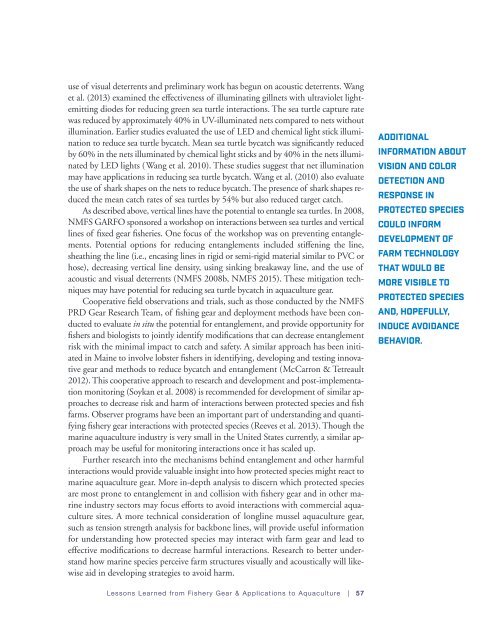Protected Species and Marine Aquaculture Interactions
x9Jh2
x9Jh2
You also want an ePaper? Increase the reach of your titles
YUMPU automatically turns print PDFs into web optimized ePapers that Google loves.
use of visual deterrents <strong>and</strong> preliminary work has begun on acoustic deterrents. Wang<br />
et al. (2013) examined the effectiveness of illuminating gillnets with ultraviolet lightemitting<br />
diodes for reducing green sea turtle interactions. The sea turtle capture rate<br />
was reduced by approximately 40% in UV-illuminated nets compared to nets without<br />
illumination. Earlier studies evaluated the use of LED <strong>and</strong> chemical light stick illumination<br />
to reduce sea turtle bycatch. Mean sea turtle bycatch was significantly reduced<br />
by 60% in the nets illuminated by chemical light sticks <strong>and</strong> by 40% in the nets illuminated<br />
by LED lights (Wang et al. 2010). These studies suggest that net illumination<br />
may have applications in reducing sea turtle bycatch. Wang et al. (2010) also evaluate<br />
the use of shark shapes on the nets to reduce bycatch. The presence of shark shapes reduced<br />
the mean catch rates of sea turtles by 54% but also reduced target catch.<br />
As described above, vertical lines have the potential to entangle sea turtles. In 2008,<br />
NMFS GARFO sponsored a workshop on interactions between sea turtles <strong>and</strong> vertical<br />
lines of fixed gear fisheries. One focus of the workshop was on preventing entanglements.<br />
Potential options for reducing entanglements included stiffening the line,<br />
sheathing the line (i.e., encasing lines in rigid or semi-rigid material similar to PVC or<br />
hose), decreasing vertical line density, using sinking breakaway line, <strong>and</strong> the use of<br />
acoustic <strong>and</strong> visual deterrents (NMFS 2008b, NMFS 2015). These mitigation techniques<br />
may have potential for reducing sea turtle bycatch in aquaculture gear.<br />
Cooperative field observations <strong>and</strong> trials, such as those conducted by the NMFS<br />
PRD Gear Research Team, of fishing gear <strong>and</strong> deployment methods have been conducted<br />
to evaluate in situ the potential for entanglement, <strong>and</strong> provide opportunity for<br />
fishers <strong>and</strong> biologists to jointly identify modifications that can decrease entanglement<br />
risk with the minimal impact to catch <strong>and</strong> safety. A similar approach has been initiated<br />
in Maine to involve lobster fishers in identifying, developing <strong>and</strong> testing innovative<br />
gear <strong>and</strong> methods to reduce bycatch <strong>and</strong> entanglement (McCarron & Tetreault<br />
2012). This cooperative approach to research <strong>and</strong> development <strong>and</strong> post-implementation<br />
monitoring (Soykan et al. 2008) is recommended for development of similar approaches<br />
to decrease risk <strong>and</strong> harm of interactions between protected species <strong>and</strong> fish<br />
farms. Observer programs have been an important part of underst<strong>and</strong>ing <strong>and</strong> quantifying<br />
fishery gear interactions with protected species (Reeves et al. 2013). Though the<br />
marine aquaculture industry is very small in the United States currently, a similar approach<br />
may be useful for monitoring interactions once it has scaled up.<br />
Further research into the mechanisms behind entanglement <strong>and</strong> other harmful<br />
interactions would provide valuable insight into how protected species might react to<br />
marine aquaculture gear. More in-depth analysis to discern which protected species<br />
are most prone to entanglement in <strong>and</strong> collision with fishery gear <strong>and</strong> in other marine<br />
industry sectors may focus efforts to avoid interactions with commercial aquaculture<br />
sites. A more technical consideration of longline mussel aquaculture gear,<br />
such as tension strength analysis for backbone lines, will provide useful information<br />
for underst<strong>and</strong>ing how protected species may interact with farm gear <strong>and</strong> lead to<br />
effective modifications to decrease harmful interactions. Research to better underst<strong>and</strong><br />
how marine species perceive farm structures visually <strong>and</strong> acoustically will likewise<br />
aid in developing strategies to avoid harm.<br />
Additional<br />
information about<br />
vision <strong>and</strong> color<br />
detection <strong>and</strong><br />
response in<br />
protected species<br />
could inform<br />
development of<br />
farm technology<br />
that would be<br />
more visible to<br />
protected species<br />
<strong>and</strong>, hopefully,<br />
induce avoidance<br />
behavior.<br />
lessons lear ned from Fishery Gear & applications to aquaculture | 57


